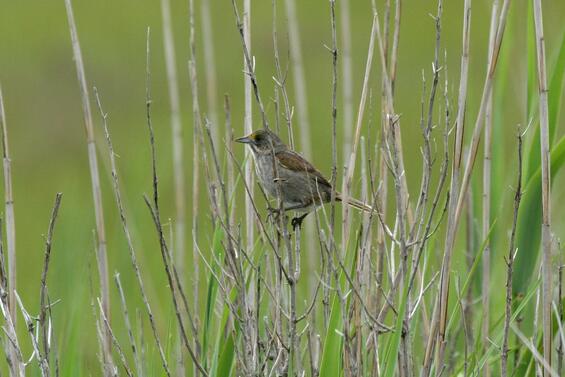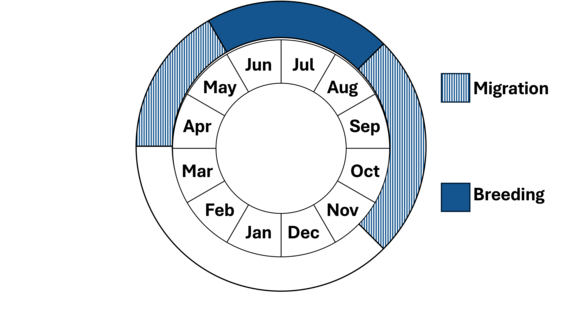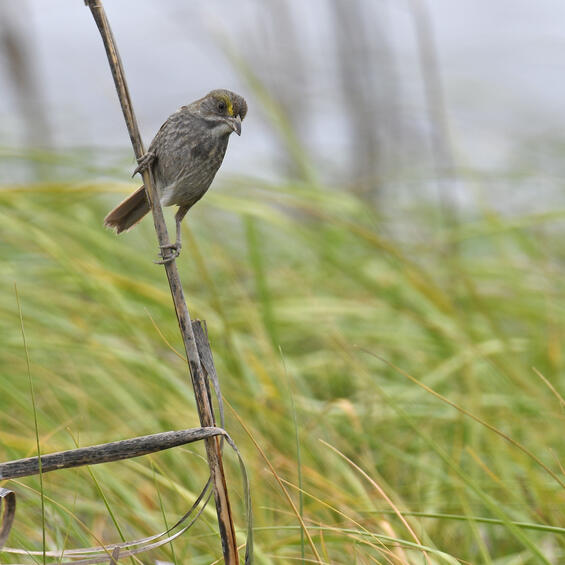- Scientific name: Ammospiza maritima
Species of Greatest Conservation Need (MA State Wildlife Action Plan)
Description

Seaside sparrow
This is a dark, olive-gray sparrow, 15 cm (6 in) in length, with a sharp tail, elongated beak, and a small yellow patch in front of the eye. Its song is cut-cut-zhe'-eeeeee, similar to saltmarsh sharp-tailed sparrow, but with a stronger accented zhe in the middle. The sexes have a similar appearance, but juveniles have more buffy coloration and lack the rufous wing patch compared to adults. The species can be confused with the saltmarsh sparrow that looks similar and is found in the same type of habitat, but the seaside sparrow is larger, grayer, has less buffy coloration through the face and upper chest, and has a larger bill.
Life cycle and behavior

Phenology in Massachusetts. This is a simplification of the annual life cycle. Timing exhibited by individuals in a population varies, so adjacent life stages generally overlap each other at their starts and ends.
This short-distance migratory sparrow begins to arrive in Massachusetts in late April and numbers increase through the first half of May. Males tend to arrive first and begin to establish territories prior to the arrival of females. The seaside sparrow lives in salt and brackish marsh habitat and nest in herbaceous vegetation close to the ground. Although the species may produce multiple broods south of Massachusetts, they are typically single brooded in New England but often renest following nest failure. Their clutch size ranges from 2-5 eggs (most commonly 4 eggs), incubation averages 12.3 days, and chicks fledge from the nest 9 days after hatching. Fall migration may begin as early as late August, but most birds don’t depart their nesting areas until later in September and October.
Population status
Although Breeding Bird Survey data indicate that this species has an annual increasing population trend of 1.2% range-wide between 1966-2022, these results should be viewed cautiously as this survey effort contains limited data for species that nest in salt marsh habitat. Recently, a more intensive study focused on salt marsh birds found no population trend from 1994-2012 for seaside sparrows nesting between Maine and Virginia. The highest population densities of nesting birds have been reported along Long Island, NY and the Delmarva Peninsula.
Distribution and abundance
Seaside sparrows nest in coastal salt marshes along the Atlantic and Gulf coasts from southern Maine to Texas and Massachusetts is near the northern limit of their breeding range. They are rare and very locally distributed in salt marshes in the vicinity of Plum Island and Parker River in Essex County, at Sandy Neck and Monomoy on Cape Cod, and at South Dartmouth in Bristol County. Birds nesting in the Northeast are thought to winter in salt marshes from North Carolina to Florida. MassWildlife’s Natureal Heritage and Endangered Species Program does not track occurrences of seaside sparrows in Massachusetts.
Habitat
Nesting occurs in salt marshes on or near the ground and just above high tide levels. The sparrow nests in both high and low salt marsh, the former dominated by saltmarsh hay (Spartina patens), black grass (Juncus gerardii), and scattered marsh elder (Iva frutescens); the latter dominated by saltwater cordgrass (Spartina alterniflora). Seaside sparrows are more likely to nest in lower, S. alterniflora-dominated sections of marsh than are saltmarsh sharp-tailed sparrows. Nests are susceptible to flooding from especially high tides. This species seems to be limited to a subset of the largest and least degraded salt marshes in Massachusetts, suggesting that it may be sensitive to the size of wetland area or some other landscape features in its selection of salt marsh habitat.
Healthy habitats are vital for supporting native wildlife and plants. Explore habitats and learn about conservation and restoration in Massachusetts.

Threats
This species is at risk in Massachusetts because of its rarity, limited distribution, and narrow habitat niche. Modification or degradation of its salt marsh habitat – for example, by dredging and filling, ditching, diking, invasion by exotic vegetation, spraying of insecticides, oil spills, or long-term effects of sea level rise – could threaten local populations and their salt marsh habitat.
An additional threat to the species is collisions with buildings and other structures, as approximately 1 billion birds in the United States are estimated to die annually from building collisions. A high percentage of these collisions occur during the migratory periods when birds fly long distances between their wintering and breeding grounds. Light pollution exacerbates this threat for nocturnal migrants as it can disrupt their navigational capabilities and lure them into urban areas, increasing the risk of collisions or exhaustion from circling lit structures or areas.
Conservation
Habitat protection and management is important for the conservation of this species. Successful restoration of degraded salt marsh habitat will likely be critical to maintain breeding habitat for the seaside sparrow with rising ocean levels and an increase in storm numbers and intensity. Conservation organizations are currently planning and implementing nature-based salt marsh habitat restoration projects in Massachusetts.
Bird collision mortalities can be minimized by making glass more visible to birds. This includes using bird-safe glass in new construction and retrofitting existing glass (e.g., screens, window decals) to make it bird-friendly and reducing artificial lighting around buildings (e.g., Lights Out Programs, utilizing down shielding lights) that attract birds during their nocturnal migration.
References
Petersen, W.R., and W.R. Meservey. 2003. Massachusetts Breeding Bird Atlas. Massachusetts Audubon Society and University of Massachusetts Press, Amherst, Massachusetts.
Greenlaw, J. S., W. G. Shriver, and W. Post (2022). Seaside Sparrow (Ammospiza maritima), version 2.0. In Birds of the World (P. G. Rodewald and B. K. Keeney, Editors). Cornell Lab of Ornithology, Ithaca, NY, USA. https://doi.org/10.2173/bow.seaspa.02
Hostetler, J.A., Sauer, J.R., Hines, J.E., Ziolkowski, D., and Lutmerding, M., 2023, The North American Breeding Bird Survey, Analysis Results 1966 - 2022: U.S. Geological Survey data release, https://doi.org/10.5066/P9IU1UZ6.
Veit, R., and W.R. Petersen. 1993. Birds of Massachusetts. Massachusetts Audubon Society, Lincoln, Massachusetts.
Contact
| Date published: | April 2, 2025 |
|---|